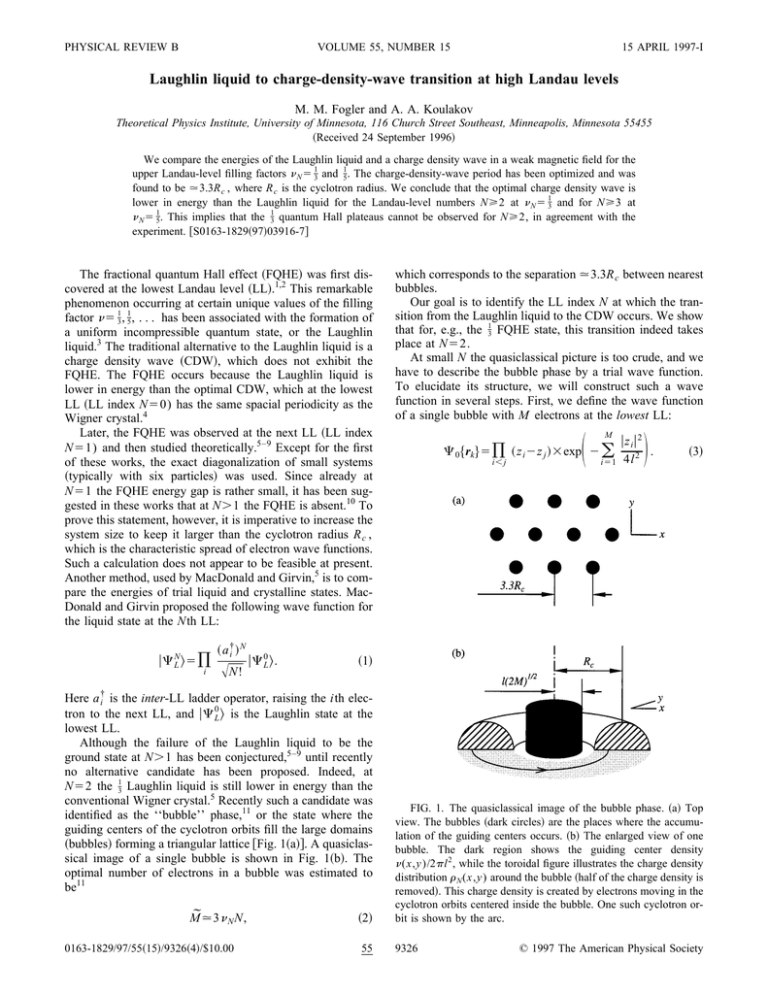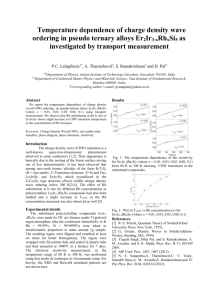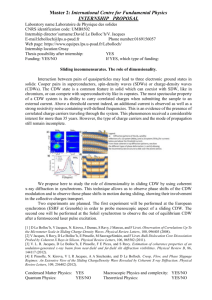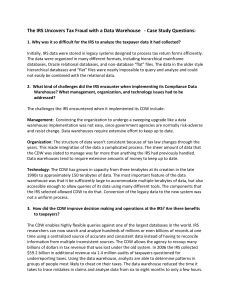Laughlin liquid to charge-density-wave transition at high Landau levels
advertisement

PHYSICAL REVIEW B VOLUME 55, NUMBER 15 15 APRIL 1997-I Laughlin liquid to charge-density-wave transition at high Landau levels M. M. Fogler and A. A. Koulakov Theoretical Physics Institute, University of Minnesota, 116 Church Street Southeast, Minneapolis, Minnesota 55455 ~Received 24 September 1996! We compare the energies of the Laughlin liquid and a charge density wave in a weak magnetic field for the upper Landau-level filling factors n N 5 31 and 51. The charge-density-wave period has been optimized and was found to be .3.3R c , where R c is the cyclotron radius. We conclude that the optimal charge density wave is 1 lower in energy than the Laughlin liquid for the Landau-level numbers N>2 at n N 5 3 and for N>3 at n N 5 51. This implies that the 31 quantum Hall plateaus cannot be observed for N>2, in agreement with the experiment. @S0163-1829~97!03916-7# The fractional quantum Hall effect ~FQHE! was first discovered at the lowest Landau level ~LL!.1,2 This remarkable phenomenon occurring at certain unique values of the filling factor n 5 31 , 15 , . . . has been associated with the formation of a uniform incompressible quantum state, or the Laughlin liquid.3 The traditional alternative to the Laughlin liquid is a charge density wave ~CDW!, which does not exhibit the FQHE. The FQHE occurs because the Laughlin liquid is lower in energy than the optimal CDW, which at the lowest LL ~LL index N50) has the same spacial periodicity as the Wigner crystal.4 Later, the FQHE was observed at the next LL ~LL index N51) and then studied theoretically.5–9 Except for the first of these works, the exact diagonalization of small systems ~typically with six particles! was used. Since already at N51 the FQHE energy gap is rather small, it has been suggested in these works that at N.1 the FQHE is absent.10 To prove this statement, however, it is imperative to increase the system size to keep it larger than the cyclotron radius R c , which is the characteristic spread of electron wave functions. Such a calculation does not appear to be feasible at present. Another method, used by MacDonald and Girvin,5 is to compare the energies of trial liquid and crystalline states. MacDonald and Girvin proposed the following wave function for the liquid state at the Nth LL: u C NL & 5 )i ~ a †i ! N AN! u C 0L & . 0163-1829/97/55~15!/9326~4!/$10.00 C 0 $ rk % 5 ) i, j S ~ z i 2z j ! 3exp 2 M ( i51 D u z iu 2 . 4l 2 ~3! ~1! Here a †i is the inter-LL ladder operator, raising the ith electron to the next LL, and u C 0L & is the Laughlin state at the lowest LL. Although the failure of the Laughlin liquid to be the ground state at N.1 has been conjectured,5–9 until recently no alternative candidate has been proposed. Indeed, at N52 the 31 Laughlin liquid is still lower in energy than the conventional Wigner crystal.5 Recently such a candidate was identified as the ‘‘bubble’’ phase,11 or the state where the guiding centers of the cyclotron orbits fill the large domains ~bubbles! forming a triangular lattice @Fig. 1~a!#. A quasiclassical image of a single bubble is shown in Fig. 1~b!. The optimal number of electrons in a bubble was estimated to be11 M̃ .3 n N N, which corresponds to the separation .3.3R c between nearest bubbles. Our goal is to identify the LL index N at which the transition from the Laughlin liquid to the CDW occurs. We show that for, e.g., the 31 FQHE state, this transition indeed takes place at N52. At small N the quasiclassical picture is too crude, and we have to describe the bubble phase by a trial wave function. To elucidate its structure, we will construct such a wave function in several steps. First, we define the wave function of a single bubble with M electrons at the lowest LL: ~2! FIG. 1. The quasiclassical image of the bubble phase. ~a! Top view. The bubbles ~dark circles! are the places where the accumulation of the guiding centers occurs. ~b! The enlarged view of one bubble. The dark region shows the guiding center density n (x,y)/2p l 2 , while the toroidal figure illustrates the charge density distribution r N (x,y) around the bubble ~half of the charge density is removed!. This charge density is created by electrons moving in the cyclotron orbits centered inside the bubble. One such cyclotron orbit is shown by the arc. 55 9326 © 1997 The American Physical Society BRIEF REPORTS 55 9327 Here z j 5x j 1iy j is the complex coordinate of the jth electron, and l is the magnetic length. Second, we construct the wave function of a bubble at the Nth LL centered at point R. This is achieved with the help of the magnetic translation and inter-LL ladder operators, M C $ rk % 5 ) i51 ~ a †i ! N AN! exp S b †i R̄2b i R l A2 D C 0 $ rk % , ~4! where b i is an intra-LL ladder operator. To finally obtain the wave function of the CDW, we build an antisymmetric combination of the bubbles centered at the triangular lattice sites Rl , C CDW5 (P sgn~ P ! )l C l $ P ~ rk ! % . ~5! Here P’s are the permutations of electrons between bubbles. For the case M 51 this trial state coincides with the Wigner crystal wave function.13 It can be easily seen that C CDW is of the Fock type, and that the overlap between the wave functions of different bubbles ~for M 53 n N N) is negligible. It proves to be useful for further calculations to introduce the guiding center density n̂ ~ r! 52 p l 2 (i d ~ r2R̂i ! . F M K 5L KM 2K S D q 2 l 2 2q 2 l 2 /4 e , 2 ~7! where A is the area of the system, and L KM (x) is the Laguerre polynomial. Now we would like to find the cohesive energy E CDW coh of our trial state. The calculation is quite similar to the case of the lowest LL,4 E CDW coh 5 1 2nN ( qÞ0 U u HF~ q ! ^ n̂ ~ q ! & A U 2 ~8! ~see Ref. 11 for details!. The summation in Eq. ~8! is carried over the reciprocal vectors of the triangular lattice. The Hartree-Fock interaction potential u HF(q) is defined as follows ~cf. Ref. 11!: u HF~ q ! 5u H~ q ! 2u ex~ q ! , u H~ q ! 5 u ex~ q ! 52 p l 2 v~ q ! F ~ q !, 2 p l 2 e ~ q ! NN E Here e (q) takes into account the screening of the Coulomb interaction among the electrons at the upper LL by lower LL’s. It is given by12 e ~ q ! 511 v~ q ! P ~ q ! , ~6! The summation here is carried over the electrons at the considered LL, and R̂i 5ri 1(1/v c ) @ ẑ3v̂i # is the guiding center operator, with v̂i and v c being the velocity of the ith particle and the cyclotron frequency, respectively.14 It can be shown that for the state defined by Eq. ~5!, n NA F ~ q !, ^ n̂ ~ q ! & 5 M M M 21 FIG. 2. The cohesive energy of the CDW as a function of n N for different numbers of electrons in a bubble M . The calculations are made for N55 and r s 5 A2. The crosses mark the Laughlin liquid energies. d 2q 8 i 2 e qq 8 l u H~ q 8 ! . ~ 2p !2 P~ q !5 2 ~ 21 ! n2m F ~ q ! F mn ~ q ! , 2 p l m,N<n \ v c ~ n2m ! nm ( ~9! ~10! where v (q)52 p e 2 / k q is the Coulomb potential. This dielectric function tends to unity in the limits q→0 and q→`, and reaches its largest value of 11 A2Nr s at 2 q;R 21 c . Here r s 5 A2e / k \ v F is the gas parameter. Accounting for the LL mixing by means of the dielectric function was shown to be accurate provided r s !1 and Nr s @1 ~Ref. 12!. Moreover, the results obtained within the framework of this model remain correct to the leading order in r s even for Nr s !1. In the latter limit e (q).1, which is consistent with the fact that the LL mixing can be ignored completely. Using Eqs. ~7! and ~8!, the cohesive energy for any given n N can be calculated numerically. The result is, of course, different for different values of M ~see Fig. 2!. Therefore, one has to find M̃ corresponding to the lowest energy. The energies of the CDW optimized in this way are summarized in Tables I and II. Notice that the energy unit used in the tables, r s \ v c , differs from e 2 / k l traditionally used in the case of the lowest LL. The reason for this difference is that, at high LL’s, the relevant length scale is not the magnetic length l but the cyclotron radius R c 5 A2N11l. Hence the natural energy scale is e 2 / k R c , which coincides with r s \ v c up to a numerical factor.11 In Table I we present the results for the case Nr s !1, when the LL mixing can be ignored completely, i.e., e (q)[1. Table II contains the results for the case r s 5 A2, which corresponds to the practical range of electron densities in GaAs heterostructures. One can see that the optimal number of electrons per bubble is the same both with and without the screening, and is in perfect agreement with Eq. ~2!. 9328 55 BRIEF REPORTS TABLE I. The cohesive energies of the Laughlin liquid E Lcoh and the CDW E CDW coh in the limit r s →0. M̃ is the optimal number of electrons per bubble. The energy unit is r s \ v c . The energy per electron in the uniform uncorrelated state E UEL is provided for reference. Correlated crystal E CDW coh 520.2473r s \ v c . N M̃ E UEL 0 1 2 3 4 5 1 1 2 3 4 5 20.0853 20.1692 20.1970 20.2135 20.2251 20.2341 N M̃ E UEL 0 1 2 3 4 5 1 1 1 2 2 3 20.0396 20.0986 20.1164 20.1267 20.1340 20.1395 n N 5 31 E Lcoh 20.0820~1! 20.1831~3! 20.1925~4! 20.2073~5! 20.2226~6! 20.2340~7! n N 5 51 E Lcoh 20.0638~1! 20.2110~4! 20.2473~6! 20.2458~8! 20.2481~9! 20.2569~9! E CDW coh d E/E CDW coh 20.0733 20.1726 20.2163 20.2433 20.2480 20.2767 211.9% 26.1% 11.0% 14.8% 10.3% 15.4% E CDW coh d E/E CDW coh 20.0622 20.2043 20.2454 † 20.2811 20.2990 20.3187 22.7% 23.3% 20.75% 12.6% 17.0% 19.4% TABLE II. Same as Table I, but r s 5 A2, which corresponds to the electron density of 1.631011 cm22 in GaAs-Al x Ga 12x As heterostructures. The energies are now given in the units of \ v c . N M̃ 0 1 2 3 4 5 1 1 2 3 4 5 N M̃ 0 1 2 3 4 5 1 1 1 2 2 3 E 20.1206 20.1297 20.1136 20.1034 20.0965 20.0914 E UEL 20.0560 20.0765 20.0677 20.0618 20.0577 20.0547 V m5 1 2p n N 5 31 E Lcoh E CDW coh d E/E CDW coh 20.1159~1! 20.1519~3! 20.1141~3! 20.0946~3! 20.0824~3! 20.0733~3! 20.1037 20.1424 20.1188 20.1018 20.0896 20.0805 211.8% 26.7% 4.0% 7.1% 8.0% 8.9% n N 5 51 E Lcoh E CDW coh d E/E CDW coh 20.0903~2! 20.1727~7! 20.1420~9! 20.1139~9! 20.0963~9! 20.0849~9! 20.0880 20.1692 20.1396 20.1202 20.1050 20.0946 22.6% 22.1% 21.7% 5.2% 8.3% 10.3% E d 2 qu H~ q ! F mm ~ A2q ! . ~11! In particular, the cohesive energy of the Laughlin liquid can be written in the following form: ` E Lcoh5 nN c V . p m51 m m ( ~12! In this formula c m are the coefficients in the expansion15 ` h ~ r ! 52 The above results have been tested by the self-consistent Hartree-Fock procedure, similar to that described in Ref. 4. Starting from the initial approximation given by wave function ~5!, this procedure finds the optimal set of ^ n̂ (q) & for a given periodicity of the CDW. The obtained corrections are of the order of 1025 r s \ v c , and do not affect the significant digits displayed in Tables I and II. We associate the corrections with a slight nonorthogonality of the wave functions of different bubbles. Let us now discuss the Laughlin liquid at high LL’s. As UEL Haldane pointed out in Ref. 1, the interaction of electrons confined to a single LL is described by means of a discrete set of pseudopotentials V m defined by c m ( m51 m! S D r2 4l 2 2m e 2r 2 /4l 2 ~13! for the density-density correlation function h(r) of the Laughlin liquid at the lowest LL, h~ r 





